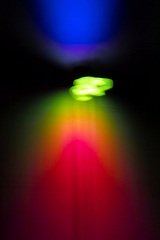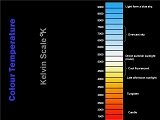Colour-Temperature
Colour-Temperature describes the spectrum of light which is radiated by heat absorbent object referred to as a "blackbody" and measured in degrees Kelvin.
Think of a "Black Body" object as a theoretical object or better still, a metal with special properties which can absorb heat indefinitely without reaching a melting point.As the Black Body absorbs heat it begins to glow. Red hot at first, then white hot as the Black Body absorbs heat then blue hot at the top of the Kelvin scale.
Colour-Temperature is a measure of light energy expressed in degrees Kelvin(K) not heat Fahrenheit or Celsius.
Higher Colour-Temperature means that the light source is closer to the blue end
( higher energy end ) of the spectrum, and lower temperature means the light source is closer to the red end ( lower energy end ) of the spectrum.
Try this
you put two different light sources side-side in a test. You can try this experiment by holding an incandescent (regular light bulb) light source beside a fluorescent light source.
They both produce "white" light, but one shocking difference, they do not produce the same white light. The fluorescent tube or bulb may appear to have a bluish tint, while the incandescent bulb appears yellowish.
The fluorescent light has a higher Colour-Temperature (more light energy and the incandescent light has a lower Colour-Temperature (less energy).
Sometimes it seems like a contradiction
but it does makes sense.
Light below (about 3500 K) is considered to be lower on the Kelvin scale, yet appear warmer to the eye. Colour-Temperaturs above 5000 degrees Kelvin are considered higher on the Kelvin scale yet are cooler to the eye. (see the scale).
Okay, okay
I hear you asking
"so why is this important to me?"
please read on.
Manufacturers often omit any reference to Colour-Temperature. Instead they choose to use expressive, but less accurate terms such as cool white and warm white.
A better idea is to look for light fixtures in the 3500 to 4000 K range. This temperature range brings warmer tones to the garden.
 Using Coloured Light in your Garden? CLCIK HERE
Using Coloured Light in your Garden? CLCIK HERE
Above,
If you are thinking about using coloured light in your garden then here is some information for you to help you get started.
Above,
The amount of red or blue present in white light is refered to as its Colour Temperature and though it might be a little counter-intuitive, red is at the bottom of the scale and cooler while blue is at the top of the scale and hotter. Colour Temperature is measured in degrees Kelvin.

New! Comments
Have your say about what you just read! Leave me a comment in the box below.